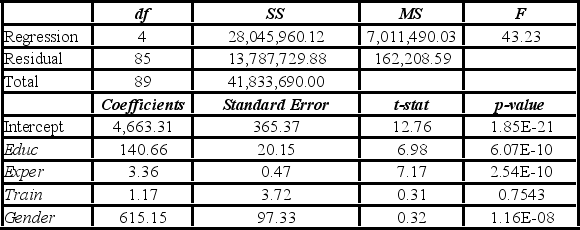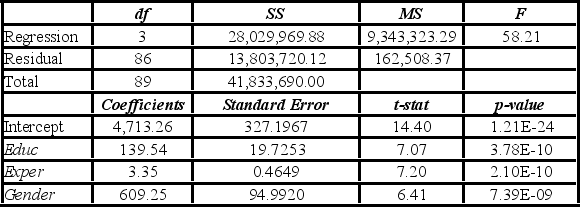Multiple Choice
To examine the differences between salaries of male and female middle managers of a large bank, 90 individuals were randomly selected, and two models were created with the following variables considered: Salary = the monthly salary (excluding fringe benefits and bonuses) ,
Educ = the number of years of education,
Exper = the number of months of experience,
Train = the number of weeks of training,
Gender = the gender of an individual; 1 for males, and 0 for females.
Excel partial outputs corresponding to these models are available and shown below.
Model A: Salary = β0 + β1Educ + β2Exper + β3Train + β4Gender + ε  Model B: Salary = β0 + β1Educ + β2Exper + β3Gender + ε
Model B: Salary = β0 + β1Educ + β2Exper + β3Gender + ε  Assuming the same years of education and months of experience, what is the p-value for testing whether the mean salary of males is greater than the mean salary of females using Model B?
Assuming the same years of education and months of experience, what is the p-value for testing whether the mean salary of males is greater than the mean salary of females using Model B?
A) At least 0.025
B) Less than 0.025 but at least 0.01
C) Less than 0.01 but at least 0.005
D) Less than 0.005
Correct Answer:

Verified
Correct Answer:
Verified
Q3: According to the Center for Disease Control
Q4: To encourage performance, loyalty, and continuing education,
Q5: A researcher wants to examine how the
Q6: The method of maximum likelihood estimation (MLE)
Q7: A bank manager is interested in assigning
Q9: Consider the regression equation <img src="https://d2lvgg3v3hfg70.cloudfront.net/TB6618/.jpg" alt="Consider
Q10: A binary choice model is also referred
Q11: A dummy variable is also called an
Q12: For the model y = β<sub>0 </sub>+
Q13: A realtor wants to predict and compare